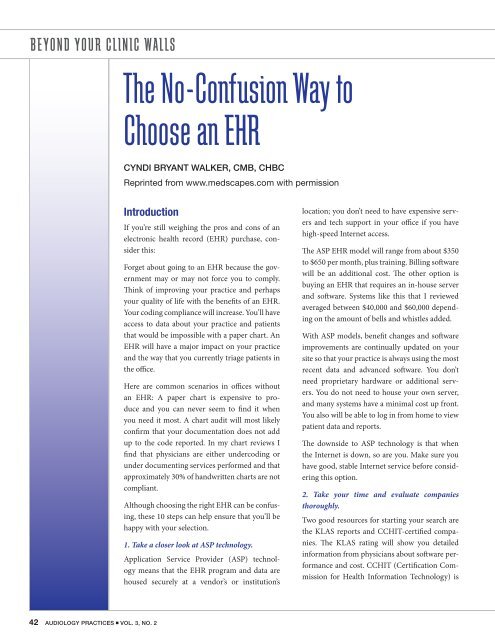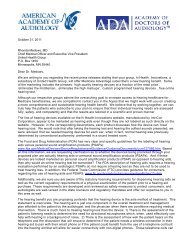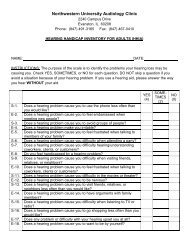IN THIS ISSUE - Academy of Dispensing Audiologists
IN THIS ISSUE - Academy of Dispensing Audiologists
IN THIS ISSUE - Academy of Dispensing Audiologists
Create successful ePaper yourself
Turn your PDF publications into a flip-book with our unique Google optimized e-Paper software.
BEYOND YOUR CL<strong>IN</strong>IC WALLS<br />
42 AUDIOLOGY PRACTICES n VOL. 3, NO. 2<br />
The No-Confusion Way to<br />
Choose an EHR<br />
CYNDI BRYANT WALKER, CMB, CHBC<br />
Reprinted from www.medscapes.com with permission<br />
Introduction<br />
If you’re still weighing the pros and cons <strong>of</strong> an<br />
electronic health record (EHR) purchase, consider<br />
this:<br />
Forget about going to an EHR because the government<br />
may or may not force you to comply.<br />
Think <strong>of</strong> improving your practice and perhaps<br />
your quality <strong>of</strong> life with the benefits <strong>of</strong> an EHR.<br />
Your coding compliance will increase. You’ll have<br />
access to data about your practice and patients<br />
that would be impossible with a paper chart. An<br />
EHR will have a major impact on your practice<br />
and the way that you currently triage patients in<br />
the <strong>of</strong>fice.<br />
Here are common scenarios in <strong>of</strong>fices without<br />
an EHR: A paper chart is expensive to produce<br />
and you can never seem to find it when<br />
you need it most. A chart audit will most likely<br />
confirm that your documentation does not add<br />
up to the code reported. In my chart reviews I<br />
find that physicians are either undercoding or<br />
under documenting services performed and that<br />
approximately 30% <strong>of</strong> handwritten charts are not<br />
compliant.<br />
Although choosing the right EHR can be confusing,<br />
these 10 steps can help ensure that you’ll be<br />
happy with your selection.<br />
1. Take a closer look at ASP technology.<br />
Application Service Provider (ASP) technology<br />
means that the EHR program and data are<br />
housed securely at a vendor’s or institution’s<br />
location; you don’t need to have expensive servers<br />
and tech support in your <strong>of</strong>fice if you have<br />
high-speed Internet access.<br />
The ASP EHR model will range from about $350<br />
to $650 per month, plus training. Billing s<strong>of</strong>tware<br />
will be an additional cost. The other option is<br />
buying an EHR that requires an in-house server<br />
and s<strong>of</strong>tware. Systems like this that I reviewed<br />
averaged between $40,000 and $60,000 depending<br />
on the amount <strong>of</strong> bells and whistles added.<br />
With ASP models, benefit changes and s<strong>of</strong>tware<br />
improvements are continually updated on your<br />
site so that your practice is always using the most<br />
recent data and advanced s<strong>of</strong>tware. You don’t<br />
need proprietary hardware or additional servers.<br />
You do not need to house your own server,<br />
and many systems have a minimal cost up front.<br />
You also will be able to log in from home to view<br />
patient data and reports.<br />
The downside to ASP technology is that when<br />
the Internet is down, so are you. Make sure you<br />
have good, stable Internet service before considering<br />
this option.<br />
2. Take your time and evaluate companies<br />
thoroughly.<br />
Two good resources for starting your search are<br />
the KLAS reports and CCHIT-certified companies.<br />
The KLAS rating will show you detailed<br />
information from physicians about s<strong>of</strong>tware performance<br />
and cost. CCHIT (Certification Commission<br />
for Health Information Technology) is










